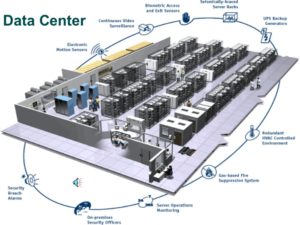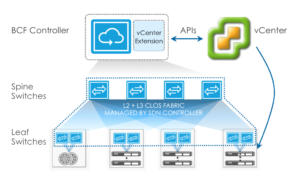Design guidelines

Welcome everybody! Today we are going to discuss the best practices and the main ideas that we must take into account when designing a data center.
First of all, we must consider the physical and non-technological characteristics that our data center should have. The data center should be placed where there are an acceptable risk of natural disasters and low possibilities of a man-made disaster. It should not share the same building with other offices, specially if they are not owned by the same organisation. A minimum reliability of 99.9% in the electrical powering utility should be guaranteed. Moreover, the electricity shall be received from separate stations and power plants, as well as water from more than one source. In addition, a fence should be placed around the building, security cameras should be set and monitored and patrolling guards should be introduced in order to control unauthorised access. Finally, computer rooms must have automatic authentication methods, fire prevention systems, backup power systems and isolated cooling towers that keep the room's temperature between 10 and 25 Celsius degrees. Here you can find more information about the data center physical security.
Next, we can consider the best practices for the network connectivity of our data center. Traditionally, a thee layer tier design (access, distribution and core) is implemented in order to offer more scalability, redundancy and failure segmentation than a flat design. Despite that, during the last years a Fabric design is the trending one, where the core is collapsed and Fabric, Virtual Port Channel and Virtual Routing and Forwarding (VRF) technology is used to hugely improve performance and efficiency, while conserving redundancy and high availability despite Spanning Tree is avoided. Furthermore, currently the use of Software Defined Networks (SDN) have become more popular in order to efficiently monitor and program the control plane of the network. Finally, it is important to point out that the majority of data centers are working with speeds of 10 Gbps and optic fibre links, even the most modern ones can reach 40 Gbps bandwidths. Click here for more information.
Resource allocation and and its connections to provide the offered services are achieved nowadays thanks to Virtualization and Cloud Computing. You can find more information about it in our other post from today.
Regarding the data storage plane, disk arrays are commonly used nowadays. Flash and HDD memory are the major part of the implemented solutions, but SSD disks are creating its own space as well. Like in the network design, redundancy is required to prevent the loss of data, and specific backup systems need to be placed. Moreover, these systems need to offer compatibility with virtualisation and SDN technologies. Here you can see our provider's data storage solutions.
Last but not least, it's important to talk about network security, which is a very critical point that will be discussed deeply in other posts. Basically, it is necessary to use New Generation Enterprise and Web Application Firewalls and Intrusion Prevention Systems in order to guarantee Application Delivery Control, Content Filtering, Secure Email and Web Gateway and Unauthorised Access and Malicious Attack Prevention. In addition, cybersecurity auditories must be periodically carried on in order to check and keep updated our data center security. As said before, this is just and initial approach which will be further developed and deeply discussed. Here you can get more information with Fortinet's Data Center Security Solution.
That's all for today folks, as always, we invite you to leave a comment and share this post, and we hope you to see you soon!


Add new comment